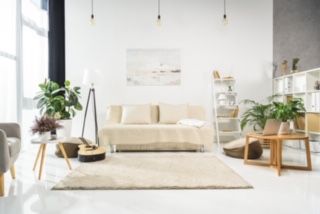Minimalism is one of those trends in the field of interior design that seems to be here to stay. The minimalistic way of decorating a home is an important part of the Scandinavian style, and in reality not much is required to give your home a minimalistic touch.
Besides being a calm and elegant way of decorating, there are some other incentives to consider when making your residence more attractive, modern and stylised. A good example is the former handball player Camilla Andersen, who was able to put her Islands Brygge apartment up for sale for a staggering 7.5 million kroner after spending only half a year in it. The apartment is for sale through realtor Paulun, which is thus selling the place for 1.3 million more than it was purchased for merely six months prior.
The location is fantastic and the square metres are impressive. But there is no doubt that the decisive factor in being able to sell it for such a high price was the work that Camilla has done regarding interior design and reconstruction.
If you choose to endeavour on a project like the former handball player, it’s a good idea to seek help for some of the larger challenges ahead. If you want to make sure that things are properly executed, you can collect different offers from painters in Copenhagen and allow yourself to sit back and watch professionals bring your dreams to life.
A minimalistic makeover can add value to your place once it hits the market, but it can also breath new life into your residence while you’re still living there, making you feel like you’ve bought a new home.
We have collated five tips for you that’ll make it easy to make your place modern and minimalistic.
Let simplicity come into its own
The keyword in Scandinavian and minimalistic design is ‘simplicity’ – regarding furniture as well as ornaments. Less is indeed more – a guideline that can be pretty straightforward while at times also quite a challenge to follow. One good piece of advice is to try and remove everything from your shelves, tables and other surfaces and only put back what is essential, or what you really want to allow to make its mark. This way, you’ll direct focus onto some carefully selected items in your home, while gifting the eye of the beholder with a calmer and more simple expression. The same goes for furniture, which should preferably be streamlined, timeless and simple.
Choose a neutral palette and spice it up with some contrast
When you choose colours, you should think in terms of neutrality and contrast. This means that large surfaces such as walls, big furniture and carpets should be a neutral colour like grey, white, beige or a light pastel colour. This does not mean that your rooms become monotonous and boring – because the next step is to spice it all up with beautiful, strong, contrasting colours. You can, for example, paint a single wall in a dark, warm earth colour, then find a pillow in a brilliant colour that complements the toned-down colours of the wall and the furniture in an excellent manner.
Think in terms of exciting, raw materials
Minimalism is also about the materials on the walls, floors, furniture and ornaments. Especially raw natural materials and mixed materials like metal and glass are ideal in the pursuit of Scandinavian minimalism. Elegant hardwood floors, wicker baskets, glass candle holders and large, green plants are a perfect fit for this style.
Immerse yourself in soft and stylish textiles
Among all the raw and streamlined material, there should be room for the ‘hyggelig’ atmosphere that is also characteristic of the Scandinavian lifestyle. Soft, plush plaids, elegant carpets and colourful pillows play a big part in minimalist interior design. You should also not be afraid of mixing different textiles – your rooms will be able to pull it off since everything else is so toned-down.
Take advantage of the empty spaces
The final tip is in line with the simplicity principle and the ‘less is more’ philosophy: it has to do with retaining the empty spaces between furniture in a room. This can result in a much more calm and minimalistic expression if, for example, you have an empty corner and a large wall painted in an elegant colour without paintings hanging on it. Or, imagine a living room where a characteristic, large couch is allowed to come into its own instead of being surrounded by a crowd of small tables and baskets close by. This does indeed help make it easier to make a room more minimalistic, as it is really about avoiding filling all spaces with knick-knacks and other small furniture.














